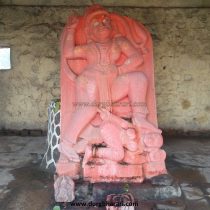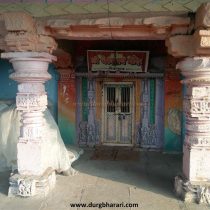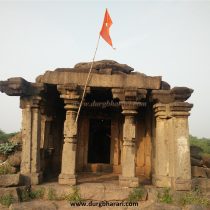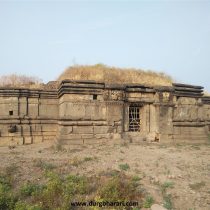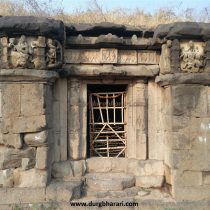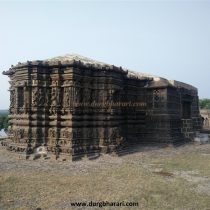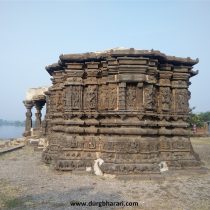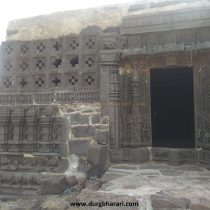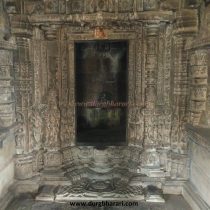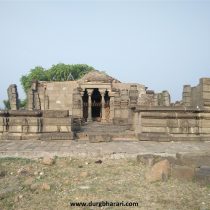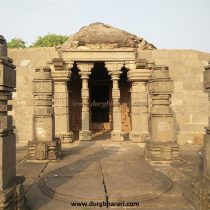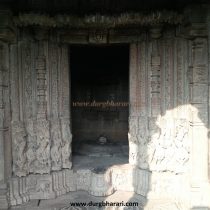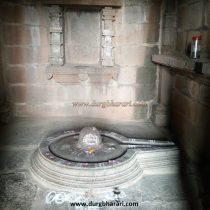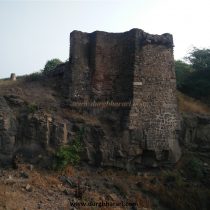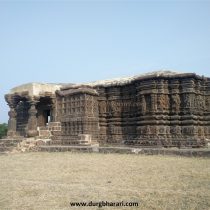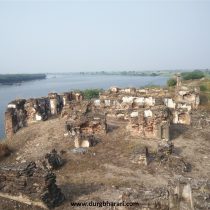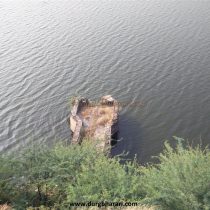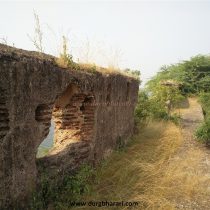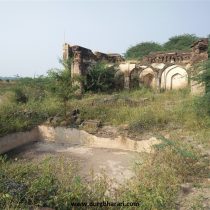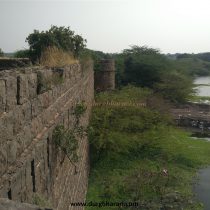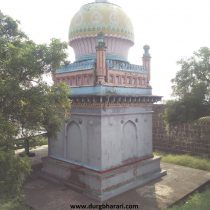BAHADURGAD
TYPE : GROUND FORT
DISTRICT : AHMEDNAGAR
HEIGHT : 0
GRADE : EASY
Pedgaon’s ground fort aka Dharmavirgad aka Bhadurgad is important in the history of Maharashtra on the north bank of river Bhima in Shrigonde taluka of Ahmednagar district. The distance from Shrigonda to Pedgaon is about 13 km and 21 km from Daund. Bahadurgad is situated between two rivers namely Bhima and Sarawati. This oval shape fort is spread across an area of 90 acres. Upon entering the village, the scattered remains of the fort begin to appear. The fort has five gates in total and there is a secret path that leads towards the direction of the river. The main entrance is in the village. The four gates of the fort have been demolished and only the arches are still standing, while the fifth gate on the riverside is still standing in good condition with its porches, but it has been closed with stones.
...
The first door is in the village, two doors are on the west side, one door is on the riverside and the fifth door is towards the Bhavani temple at the end of the fort. The gate of the fort in the village is the largest than the other four gates and before entering, a 7 feet high idol of Maruti is seen outside the gate. Both the bastions next to the gate are crumbling. As soon as you enter the fort through this gate, you can see the temple of Bhairavnath on the right and the ruins of a mansion on the left. There are five ancient temples built on Bahadurgad in the 13th century and these temples are known as Bhairavnath, Rameshwar, Mallikarjun, Laxminarayan, Baleshwar respectively. All these temples are built from basalt rock. The Bhairavnath temple is in the possession of the locals while the remaining four temples and the fort are in the possession of the Archaeological Department. Currently, the Bhairavnath temple has been painted by the villagers and its original beauty has been lost. The remaining four temples have been extensively demolished but it has been partially repaired by the Archaeological Department. In front of Bhairavnath temple, many sculptures like hero stones and Satishila are seen. There is a sculpture of Gajalaxmi in it and people have applied black color to this sculpture and also a sculpture of Shanidev. There is a deepmaal in front of the temple and some cannonballs are seen lying around it. Apart from this, the archeological department has kept idols and many other relics found on the fort near the temple in one place. Seeing all this, use the road leading to the ramparts in front. The southern ramparts of the fort are parallel to the river Bhima. Many structures in the fort have been demolished today and the remains of many houses and other palaces hidden in the bushes can be seen along the way. The ramparts of the fort are still in good condition and are covered with thorn bushes. After walking a short distance from Bhairavnath temple, on the left side, first, you can see the ruined Rameshwar temple and then the collapsed Mallikarjun temple. At a short distance away is the Hattimot building and in front of this building, you can see the other two temples in the fort. The Hattimot building is the tallest in the fort and the entire fort and its surroundings can be seen from there. From here you can see the water supply idea used for the fort. The water from the river Bhima was first pumped into the moat behind the Laxminarayan temple. From there, it was lifted by a large mud pipe and carried to the tank below Hattimot, and from there it was lifted towards the Hattimot building and carried around the entire fort with the help of mud pipes. As you walk around the fort, you can see the vent of the pipe for the flow of the air above the mud pipe. This system can still work today. The temple of Laxminarayan in front of Hattimot is still in good condition and there’s a Shivling inside this temple. The ornate pillars inside the temple as well as the idols outside are worth seeing. The Baleshwar temple in front of it, however, is in a partially collapsed state and there’s also a Shivling inside it. In short, all the five temples inside the fort are still worth visiting. Remains of a mansion can be seen on the ramparts next to the Baleshwar temple. The river Bhima is outside the ramparts at the back of the temples. After walking a short distance from the Laxminarayan temple, you can see the ramparts and entrance of the fort. To the left of the entrance is a collapsed office building. Upon entering through the entrance, you can see a court and quadrangle structures in front. It is believed that Aurangzeb and Sambhaji Raje met at this place. The construction of a two-storied mansion adjoining the ramparts is worth seeing. It is plastered with lime and is said that while Aurangzeb was at bahadurgad used to stay here. A beautiful view of the river Bhima can be seen from the windows of this mansion. Adjacent to this mansion is the bathroom and on the lower side of the mansion, you can see the jetty for the boat in the river Bhima. From here, if you proceed towards the ramparts, you will see a well-maintained gate facing the river which is fortified and closed with stones. From here, there is a temple of Goddess Bhavani outside the ramparts. There is a gate to get there through the ramparts at the front of the fort but you can't reach this gate as huge thorn bushes are growing in this area. To reach this temple, one has to go out of the fort and around the entire ramparts. The temple of Bhavani Devi stands on a quadrangle structure and its dome is built in medieval Muslim style. The temple has a separate rampart with four bastions at each end. This place is perfect for staying at the fort. This is where your fort round ends. It takes 4 hours to walk around the entire fort and its surroundings. Seeing Bahadurgad, you can see Siddhatek's Ganapati and Rashin's temples and moving towers in this area. Bahadur Khan rebuilt the fort and named it Bahadurgad. Looking at the group of five ancient temples in the fort, it seems that the fort already existed and was rebuilt by Bahadur Khan. Looking at the ancient remains on the fort, the Bhuikot of Pedgaon must have been built in the 13th century during the Yadava period of Devagiri. Shivaji Maharaj's grandfather Babaji Bhosale of Verul had this area as a Deshmukh. Pedgaon was an important center during the Nizamshahi period. There are some historical records of the administration of 52 villages under this village. During that time, the fort was under the control of the Mughals. Bahadur Khan, the southern subedar of the Mughals and Aurangzeb's brother-in-law, who had the title of Kokaltash, had rebuilt the fort in 1672 while he was living at Pedgaon on the banks of the river Bhima and renamed it Bahadurgad. This fort was the main place for storing the ammunition of the Mughal army in Pune province for a long time. Although Bahadurgad is the name of the fort, it is recorded in the British Gazetteer as a ground fort of Pedgaon. After the coronation of Chhatrapati Shivaji Maharaj, Bahadur Khan had gathered the royal treasury and two hundred excellent Arabian horses to be sent to Aurangzeb in Bahadurgad, according to Maharaj's spies. Shivaji Maharaj sent an army of nine thousand people to loot the treasure at Bahadurgad. Two parts of this army were formed. The first part consisted of two thousand people and the other had seven thousand people. The detachment of two thousand attacked Bahadurgad, drove Bahadur Khan out of the fort, and retreated. After defeating Bahadur Khan and bringing him far away, the remaining army of 7,000 Marathas attacked Bahadurgad. The Marathas marched towards Raigad, capturing the treasure and horses from the fort. When Bahadur Khan returned, he heard the news that the royal treasury had been looted and he became aware of the bravery of the Marathas. When Sambhaji Raje came to Sangameshwar in Konkan on February 1, 1689, Ganoji Shirke and Aurangzeb's Sardar Mukarrabkhan attacked Sangameshwar. Due to the small number of Marathas, the Marathas could not repel the attack despite their best efforts, and Sambhaji Raje and the poet Kalash were captured alive. Sambhaji Raje and poet Kalash were brought to Bahadurgad. At this time Aurangzeb brought his camp at Akluj to Pedgaon. Sambhaji Raje and the poet Kalash were dressed as clowns, stripped of their humiliating clothes, and brought before Aurangzeb. He was asked to hand over the Swarajya, treasures, and forts to the Mongols but Sambhaji Raje refused to surrender. Aurangzeb ordered to remove his eyes. These punishments were first given to poet Kalash and then to Sambhaji Raje. After that, both of them had their tongues cut off. This fort witnessed this sacrifice of Sambhaji Raje. They were later taken from Pedgaon to Tulapur Vadu on the Bhima-Indrayani confluence and brutally murdered them on Gudipadva. Their bodies were defaced and their remains were dumped in a river basin. Despite enduring unbearable torture for about 40 days, Sambhaji Raja did not give up his devotion.
© Suresh Nimbalkar

